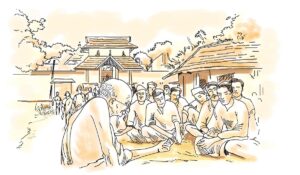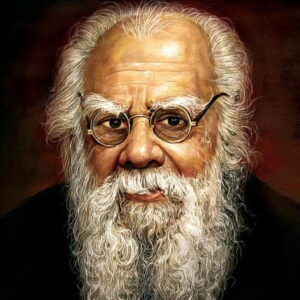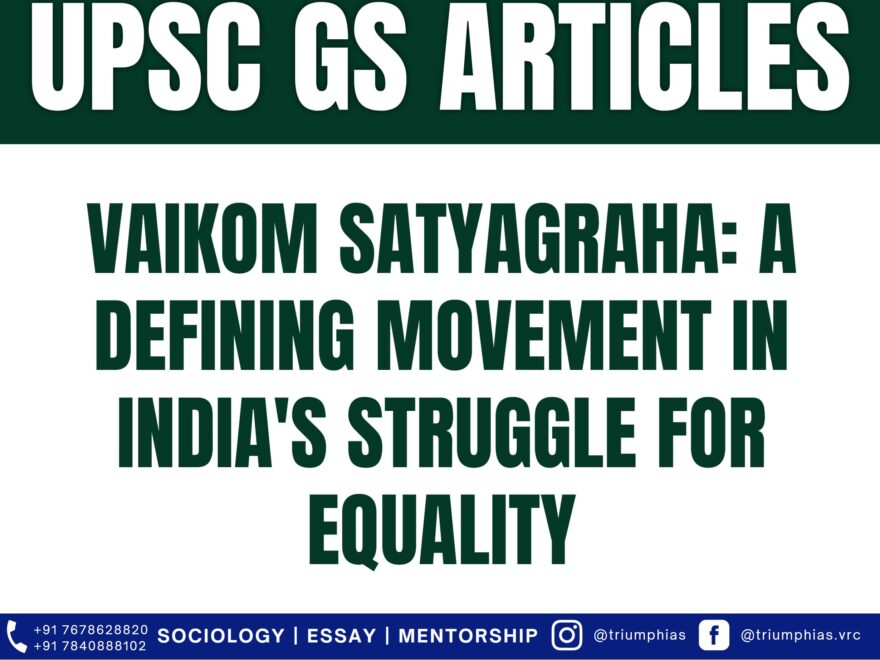Vaikom Satyagraha: A Pivotal
Battle for Human Rights
(Relevant for General Studies Paper Prelims/Mains)
India’s journey to independence from British colonial power is marked with numerous key demonstrations and campaigns, each adding to the struggle for liberty and equal rights. The Vaikom Satyagraha emerges prominently among these historic events as a powerful emblem of defiance against untouchability and caste bias.
Context
The Vaikom Satyagraha centered in Vaikom, a location in what is now Kerala, was a critical episode in the period from 1924 to 1925. It revolved around a basic, yet profound call: All individuals, irrespective of their caste status, should have the right to use the public roads surrounding the Vaikom Temple. In a society where the caste system was deeply entrenched, this was a daring and important plea.
The Satyagraha
The term ‘Satyagraha’ was coined by Mahatma Gandhi and roughly translates to ‘insistence on truth’. The Vaikom Satyagraha adopted Gandhian principles of non-violent protest and civil disobedience. The Satyagraha was organized by the Kerala Pradesh Congress Committee and involved members of various communities. A key figure in the movement was K. Kelappan, often referred to as ‘Kerala Gandhi‘ due to his commitment to Gandhian principles.

Progress and Impact
At the initial stage, the protesters were arrested and the movement seemed to lose momentum. However, the news of these arrests triggered widespread sympathy and support from across India. It became a nationwide concern, garnering attention from prominent leaders like Mahatma Gandhi and Dr. B.R. Ambedkar.
The involvement of high-caste Hindus in support of the low-caste population marked a significant turning point in the movement. Eminent personalities like Mannathu Padmanabha Pillai and K. P. Kesava Menon showed their solidarity with the protesters.
The Vaikom Satyagraha made the country take note of the severity of caste-based discrimination. It was instrumental in initiating discussions about untouchability at a national level. It culminated in the Temple Entry Proclamation in 1936, where all Hindus were allowed entry into temples in Travancore.
An Inheritance of Fairness
The enduring legacy of the Vaikom Satyagraha lies in its seminal contribution to the fight against caste-discrimination. It served as a foundational pillar for the temple entry movement in India. The impact of the Satyagraha resonated beyond the boundaries of Vaikom, igniting a nationwide series of protests for the rights of the underprivileged castes. It charted the course for subsequent movements and was instrumental in the abolishment of untouchability.
The Vaikom Satyagraha stands as an enduring symbol of the might of non-violent resistance and collective mobilization in the pursuit of social fairness. It acts as a beacon, reminding us of the struggles waged for equality, thereby etching itself as a significant episode in India’s march towards independence and societal reformation.

Periyar
Periyar E.V. Ramasamy, often succinctly called Periyar, is widely recognized as a significant figure of the Vaikom Satyagraha due to his immense input in the movement. A fervent promoter of social justice and equality, Periyar was a key actor in the struggle against caste-driven discrimination, a focal point of the Vaikom Satyagraha.
Born in Tamil Nadu, Periyar was deeply perturbed by the deeply ingrained societal discrimination underpinned by caste structure. When he became aware of the Vaikom Satyagraha and its goal of ensuring the right for all individuals, irrespective of their caste, to access the public roads around the Vaikom Temple, he perceived it as a vital struggle for human respect and parity.
Periyar not only actively engaged in the Satyagraha but also rallied support for it in Tamil Nadu. He personally directed a group of volunteers and took part in the protests. His hands-on participation and dedication to the cause not only uplifted the spirits of the satyagrahis but also attracted national scrutiny to the movement.
Moreover, Periyar utilized the Vaikom Satyagraha as a platform to disseminate his concepts of social justice and self-respect. His orations during the movement advocated the notion of social equality and criticized the repressive nature of the caste system.
His unwavering struggle against caste-centric discrimination, his staunch backing, and participation in the Vaikom Satyagraha, and his wider advocacy for social equality have secured his status as a hero of the Vaikom Satyagraha. Through his endeavors, Periyar spotlighted the degrading effects of untouchability and caste prejudice, imprinting a lasting impact on the struggle for social equality in India.
Periyar: The Vanguard of Vaikom Satyagraha
When one delves into the history of Vaikom Satyagraha, a notable movement in India’s struggle against caste bias, the name E.V. Ramasamy, more commonly known as Periyar, frequently emerges as a central figure. This article aims to explore why Periyar is celebrated as a crucial contributor to the Vaikom Satyagraha, and how his involvement influenced the direction of the movement.
Periyar: A Crusader for Social Parity
Periyar, a prominent social reformer and politician hailing from Tamil Nadu, was relentless in his fight against caste-driven discrimination and staunchly championed the rights of the marginalized castes. His passionate pursuit of social justice and equality positioned him at the helm of the Vaikom Satyagraha.
The Champion’s Voyage to Vaikom
Deeply disturbed by the deeply-seated caste-based discrimination in society, Periyar became part of the Vaikom Satyagraha. This movement fought for the right of all individuals, irrespective of caste, to use the public roads encircling the Vaikom Temple in Kerala. This demand for a fundamental right posed a formidable challenge to the then prevailing societal norms.
Periyar did more than just voice his support for the cause; he was an active participant in the protests. He led a group of volunteers from Tamil Nadu to join the satyagrahis in Vaikom. This demonstration of cross-regional unity sent a powerful message against caste prejudice.
Magnifying the Mission
Periyar’s involvement in the movement greatly enhanced its reach, drawing national eyeballs towards the Vaikom Satyagraha. His speeches, underpinned by the quest for social equality, uplifted the spirits of the demonstrators and spotlighted the tyrannical nature of the caste system for the broader populace.
A Heritage of Liberation
Periyar’s advocacy transcended his physical participation in the demonstrations. He leveraged the platform offered by the Vaikom Satyagraha to disseminate his transformative ideas about self-respect and societal justice, thereby advocating for social equality.
In his unyielding battle against caste-related discrimination, Periyar emerged as a symbol of the movement. He underscored the dehumanizing effects of untouchability and caste-based bias, creating a lasting imprint on the campaign for social equality in India.
Finale
Periyar’s proactive involvement and steadfast opposition to caste prejudice during the Vaikom Satyagraha affirm his position as a genuine hero of this historic initiative. His deeds and advocacy considerably influenced the success of the movement, propelling a more comprehensive social reform. His legacy continues to motivate generations in their continued fight for social justice and equality. Periyar’s role in the Vaikom Satyagraha stands as a testament to his lasting impact as a proponent of social equality.
Kannammal and Nagammai
Significant to the Indian social reform and self-respect movements, Kannammal and Nagammai are primarily known for their associations with E.V. Ramasamy, often referred to as Periyar.
Nagammai: Nagammai was the first wife of Periyar. She provided pivotal support to Periyar’s social reform endeavors. Deeply immersed in the Self-Respect Movement spearheaded by Periyar, Nagammai had a substantial contribution to his pursuits for women’s rights and equality. Her life journey ended in 1933.
Kannammal: Also recognized as Maniammai, Kannammal was the second wife of Periyar. She was the adoptive daughter of a colleague of Periyar. Following Nagammai’s demise, Kannammal became increasingly involved with Periyar and his social reform initiatives. She entered into matrimony with Periyar in 1948, an event that sparked controversy due to the notable age gap between them. Post Periyar’s death in 1973, Kannammal carried on his work, heading the Dravidar Kazhagam, a social group established by Periyar, until she passed away in 2003.
Both Kannammal and Nagammai had indispensable roles in backing Periyar’s endeavors for social reform, women’s rights, and the abolition of caste-based discrimination in India.
Sethu Lakshmi Bayi
Sethu Lakshmi Bayi: The Vanguard Regent of Travancore
A figure of significance yet frequently overlooked in Indian history is Sethu Lakshmi Bayi. As the Regent of the Kingdom of Travancore from 1924 to 1931, her reign was distinguished by her progressive rule and notable developmental reforms. This post delves deeper into the life and contributions of this extraordinary woman.
Early Life and Path to Regency
Born on November 19, 1895, to the Travancore royal family, Sethu Lakshmi Bayi received a stellar education, a rare privilege for women of her era. Her early progressive outlook was cultivated during this period, and it would significantly influence her future position as Regent.
In the absence of adult male heirs in 1924, Sethu Lakshmi Bayi rose to the Regency of Travancore. Even though the task was challenging, she was ready to face the hurdles that awaited her.
Era of Progressive Rule and Reform Initiatives
During her tenure as Regent, Sethu Lakshmi Bayi concentrated on progressive changes within Travancore. She approved the building of several roads, bridges, healthcare institutions, and schools, highlighting her commitment to enhancing infrastructure, healthcare, and education.
Her rule also witnessed the end of animal sacrifices in Hindu temples, a widespread practice of that era. This decision marked her as a visionary ruler, unafraid to question traditional customs in the pursuit of justice and animal rights.
Resistance and Regency’s End
Despite her efficient governance and reformative initiatives, Sethu Lakshmi Bayi faced substantial opposition from conservative factions within society and her kin. As with any path of reform, resistance was expected, but she continued to rule with resolve and a vision for a superior Travancore.
Her Regency ended in 1931 when her nephew, Sree Chithira Thirunal Balarama Varma, ascended to the throne.
Legacy
The lasting legacy of Sethu Lakshmi Bayi lies in her significant contributions towards Travancore’s development and her progressive stance on societal norms. Even though her reign was brief, she etched an enduring impression on Travancore’s history.
To this day, Sethu Lakshmi Bayi symbolizes an instance of female leadership during a time when it was quite unusual. She embodies the potent influence women can exert in shaping society and dismantling barriers.
George Joseph
George Joseph: The Undercelebrated Champion of Indian Independence
While the name George Joseph may not be as instantly recognizable in the narrative of India’s quest for independence, his contributions to the movement were nevertheless substantial and priceless. This blog post seeks to spotlight George Joseph and his pivotal role in India’s road to liberation.
Formative Years and Education
Born into a Syrian Christian family in the princely state of Travancore (now part of Kerala) on June 15, 1887, George Joseph completed his education at Madras Christian College before heading to Britain to study law.
The Stirrings of Political Consciousness
George Joseph’s political awakening took place during his time in Britain, where he was deeply moved by the Home Rule Movement’s advocacy for Indian self-governance. He was a fervent disciple of Annie Besant, the renowned Theosophist and head of the Home Rule League. Under Besant’s tutelage, Joseph’s political sensibilities were ignited, leading to his active participation in the Indian National Congress.
Involvement in the Freedom Movement
Upon his return to India, George Joseph fully immersed himself in the struggle for freedom. He played a key role in the Vaikom Satyagraha, a mass movement that demanded the right for all societal sections, regardless of caste, to use the roads encircling the Vaikom Temple.
His active involvement in the Satyagraha demonstrated his dedication to social justice and equality, the cornerstones of his political ideology. George Joseph’s participation in this movement captured national interest and broadened its influence.
Beyond the Vaikom Satyagraha, Joseph was also deeply engaged in the Salt Satyagraha, another significant movement in India’s fight for independence. His leadership in the Madurai march led to his subsequent arrest.
Legacy
George Joseph’s legacy as a champion of freedom is characterized by his steadfast commitment to justice and equality. He stood up against the established order, combatted caste discrimination, and tirelessly advocated for India’s liberation.
Though not as widely acknowledged as some of his peers, George Joseph’s contributions to India’s freedom movement were impactful and transformative. His life and efforts serve as a reminder that the quest for freedom was a collective endeavor of countless unsung heroes whose narratives deserve recognition and remembrance.
Through this blog post, we honor George Joseph – a committed freedom fighter, a passionate advocate for equality, and an undercelebrated hero of India’s independence movement.
SUKUMARAN MOOLEKKADU
- Travancore witnessed one of its most devastating floods.
- Satyagrahis stationed at the temple’s western gate found themselves submerged in water up to their necks.
- Despite these harsh conditions, they persisted in their demonstration.
- Some of the Satyagrahis were subjected to physical violence and blinded by quick lime.
- Raman Ilayathu and Amachadi Thevan sustained severe injuries from these assaults.
Prof. Sunil P Ilayidom
- During the conversation at Indamthuruthi Mana, Gandhi proposed three ideas.
- These suggestions appear odd when viewed retrospectively.
- His first contention was that the restriction on road access was not rooted in Adi Shankara’s interpretation of Hinduism.
- However, the Brahmin leaders maintained that their support for the ban was in alignment with Shankara’s teachings.
To master these intricacies and fare well in the Sociology Optional Syllabus, aspiring sociologists might benefit from guidance by the Best Sociology Optional Teacher and participation in the Best Sociology Optional Coaching. These avenues provide comprehensive assistance, ensuring a solid understanding of sociology’s diverse methodologies and techniques.
Vaikom Satyagraha, Periyar, caste discrimination, Indian Independence, Gandhian principles, social fairness, Temple Entry Proclamation, equality in India, K. Kelappan, Kerala Gandhi, Indian history, social reform, social justice, Best Sociology Optional Teacher, Best Sociology Optional Coaching, Sociology Optional Syllabus.
Follow us :
🔎 https://www.instagram.com/triumphias
🔎https://www.youtube.com/c/TriumphIAS
https://t.me/VikashRanjanSociology
Find More Blogs
|
Scope of the subject and comparison with other social sciences |
|||
|
|
|
|
Modernity and social changes in Europe |

